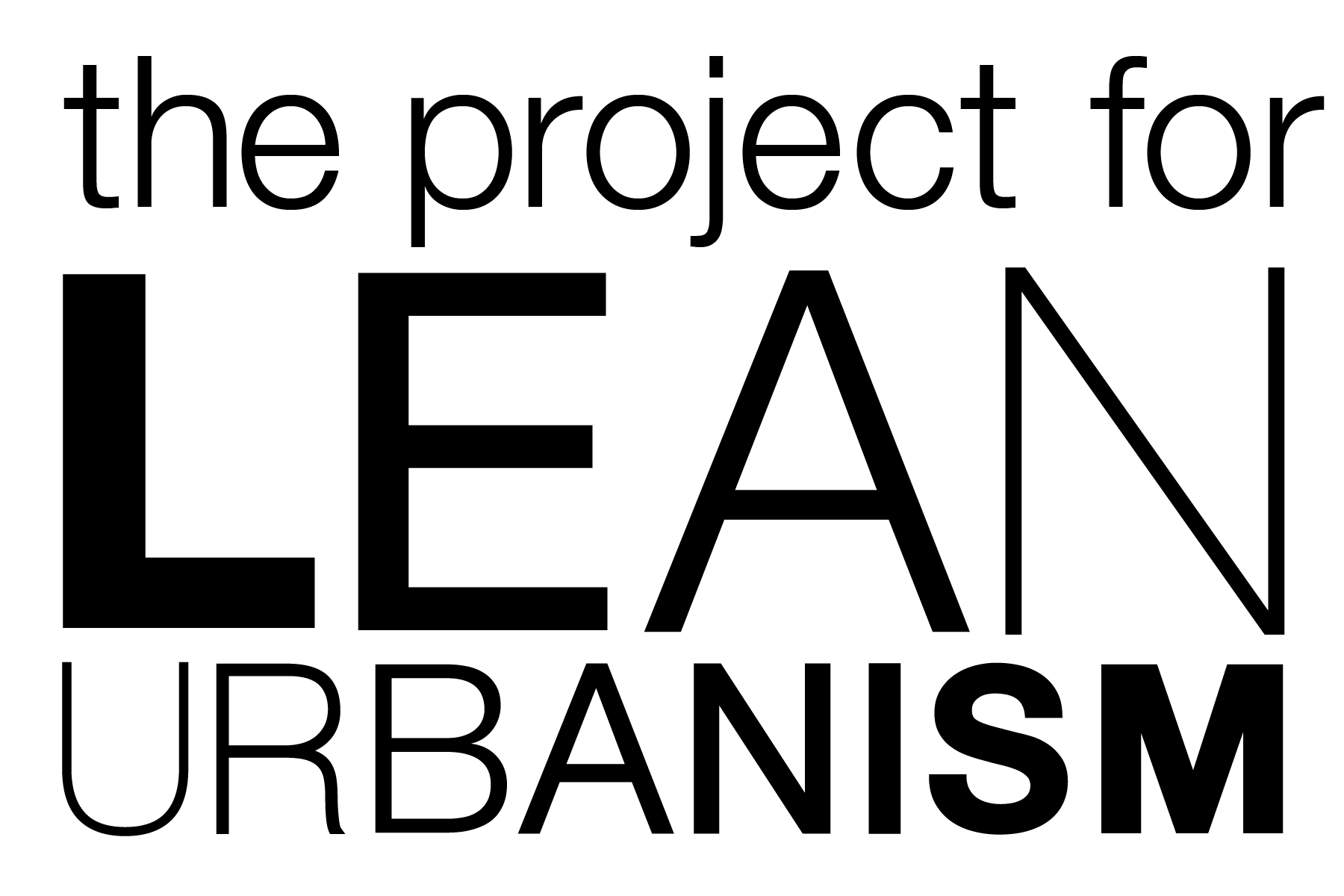About Lean Urbanism
The growing movement for Lean Urbanism seeks to address the problem that significant barriers to entry exist for too many potential contributors to community revitalization and development, especially immigrants, Millennials, and the increasing number of people restructured out of careers. Tapping into this energy will require making small, incremental development more feasible, improving access to finance, simplifying processes, and addressing the fact that many codes, regulations and standards privilege the leading market actors over small-scale builders, businesspeople, and community enterprises. The Project for Lean Urbanism seeks to address these problems with research, pilot projects, and a free kit of tools, building a movement in the process.
The Project for Lean Urbanism will restore common sense to the processes of development, building, starting small businesses, community engagement, and acquiring the necessary skills. The Project will devise tools so that community-building takes less time, reduces the resources required for compliance, and frustrates fewer well-intentioned entrepreneurs, by providing ways to work around onerous financial, bureaucratic, and regulatory processes. The tools will be made freely available to governments and organizations seeking to get things done, to entrepreneurs without the knowhow to overcome hurdles, and to small builders or homeowners who could build well in an economical, low-tech way. These include immigrants, members of the Millennial generation, makers, and other small-scale community entrepreneurs for whom the barriers to entry have become too high.
Pilot Projects
A Pink Zone — where the red tape is lightened — is the locus for implementation of Lean strategies and improvements, and it identifies an area where new protocols are pre-negotiated and experiments are conducted, all with the goal of removing impediments identified in the Lean Scan.
A custom Toolkit is developed for each Pink Zone, drawing from a range of applicable strategies, programs and initiatives developed as part of the overall project: these may include simplified codes obviating the need for later approval, Lean types of infrastructure and buildings, and strategies for enhancing the capacity of local government to expedite projects and of local businesses and community groups to act as developers.
What Is the Lean Scan?
The Lean Scan is a new tool for finding latent opportunities and leveraging under-used assets in a way that unlocks synergies between built, financial, social and natural resources. The Lean Scan is used at the scale of the neighborhood, district, corridor or town, and may be commissioned by or for a state, a locality or a community organization.
Why a Lean Scan?
No matter how comprehensive a comprehensive plan, or how masterful a master plan, implementation is often difficult in the early stages, when funding is not available or the projects are too large or too complex. The Lean Scan identifies assets of all types that can be used to build toward community goals. It also looks at obstacles to those goals. It is designed to find ways to expedite revitalization, tap into creative talent in the community, and get things moving faster.
The Lean Scan is a purposeful exercise in finding opportunities and identifying barriers. It is not about convincing the general public; it is about engaging community leadership, identifying talent and potential, and the impediments that keep them from making a better place. As opposed to a charrette — a consultation in which random groups of people are asked what they consider the problems to be — the users of the Lean Scan already know the problems (at least most of them), and use it to identify possibilities and propose solutions. The Lean Scan aims to convince only elected officials and high-ranking appointees/staff, and to engage local entrepreneurs, not the larger community. Another function of the Lean Scan is to find and unlock hidden assets, including people and organizations, so while there is an outreach function, it is targeted to finding those who have the will, talent and energy to make good things happen.
Stages of the Lean Scan
- Inventory and define underutilized or latent assets: natural, social, built, or economic, such as under-occupied buildings, business organizations, and areas where there has been a recent population influx.
- Map these assets at the scale of the corridor, the neighborhood and the block.
- Identify regulatory, financial and other barriers.
- Look for possible points of integration; define supporting levels of association such as Business Improvement Districts, non-profit and for-profit community-scale developers, and Main Street groups.
Workshop Following the Lean Scan
- Define incremental interventions that mobilize assets across multiple categories, unlocking synergy.
- Develop tools for the Lean Toolkit: rehab, infrastructure, building, and tactics, thresholds, workarounds, etc.
- Condense findings and proposals into an action plan.
About the Inventory
The Lean Scan is partly an inventory of opportunities and assets, and partly an identification of barriers and obstacles to which Lean thinking, workarounds and hacks can be applied to enable small-scale, incremental development and improvement. A simple initial template will be provided ahead of the arrival of the Lean Scan team, and this will form the basis for the targeted tours, meetings and investigations undertaken by the team when they arrive on site. The local instrument will be supplemented by an analysis of available data from online and municipal sources, looking at such things as transportation assets and corridors, connectivity, property abandonment and tax arrears, business startups and failures by area, household formation and in- and out-migration at the neighborhood scale.
The Importance of Social Capital
A main objective of a Lean Scan is to tap into and link local networks with one another and with hidden physical, natural and financial assets in a community. As such the Lean Scan includes an inventory of social capital within the subject area, finding and assessing the energy of regional local and neighborhood groups and initiatives. These might include business improvement districts, non-profit housing or community-development corporations, neighborhood associations, Main Street associations, heritage groups, “friends” groups (of parks, buildings, rivers, etc.), local chambers of commerce, local development organizations, as well as public markets and farmer’s markets. Local government will be considered, for example as a potential developer/facilitator through benefit assessment, TIF, etc.
At a more specific level, the Scan will identify groups with an appetite for Lean Urbanism: co-housing groups or other cooperatives, landowners/business owners on a block, maker places and arts centers, and condo or homeowner associations.
The Lean Scan assesses capacity, makes linkages, and proposes roles for active and relevant groups in the incremental improvement of the area through an action plan and the designation of a Pink Zone to lighten red tape. In addition, the Scan will identify a candidate group or groups to be the local coordinator, the focus of technical assistance, the interface with expeditors in local government, and the platform for shared resources and multi-party projects.
What is the Product of the Lean Scan?
The Lean Scan will result in a report and presentation which will guide the Action Plan and Pink Zone workshop to follow. It narrows the field of investigation to short-term improvements and developments, shifts the focus from the master plan and the large-scale developer to local initiatives and achievable results, and it helps to identify the likely members of the implementation team that will be forged in the project.
The Lean Scan is thus an essential part of shifting the focus in a community from comprehensive plans that are difficult to implement to near-term opportunities that take the community closer to its long-term goals.
Hank Dittmar is a global sustainability authority and urbanist, advising governments, companies and communities all over the world on making cities and towns more liveable and resilient.
He was Chief Executive for The Prince's Foundation for Building Community from 2005-2013. Prior to that, Hank was Founding President and CEO of Reconnecting America, and was Chairman of the Congress for the New Urbanism from 2003-2008. He has been the head of a U.S.-based foundation, a regional planner, an airport director, and an outreach worker with street gangs in Chicago's inner city.
A Senior Research Associate at the University of Oxford's Department for Continuing Education, he is the author of the 2008 book Transport and Neighbourhoods (Edge Futures/Black Dog, 2008), and co-author and editor of New Transit Town – Best Practices in Transit Oriented Development (Island Press, 2004).

